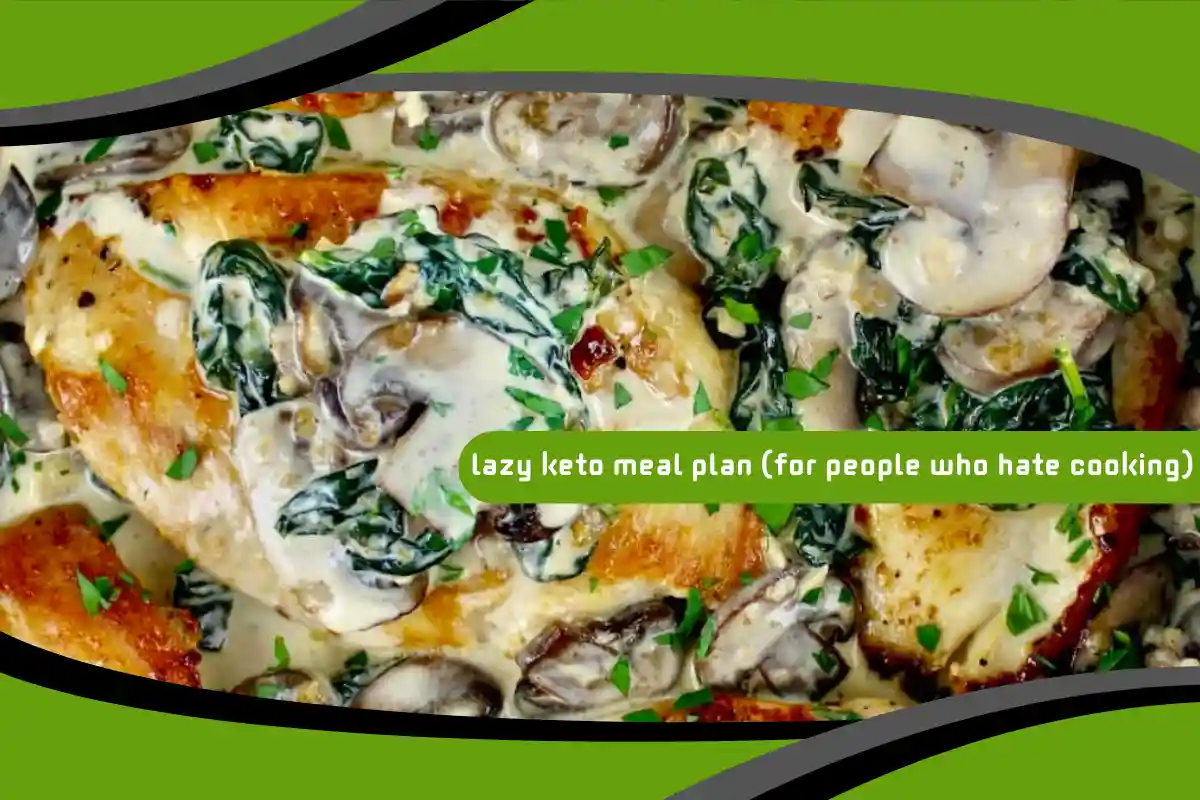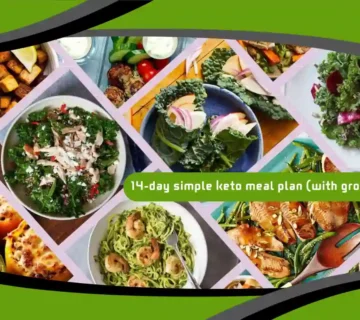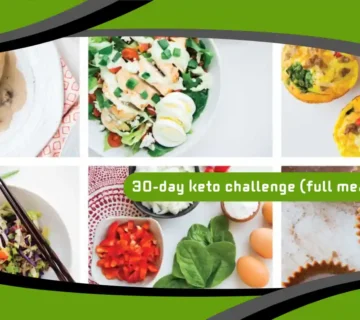The ketogenic diet has become increasingly popular due to its potential for weight loss, appetite control, and improved energy levels. But for many, the idea of constantly cooking, meal prepping, and calculating macros is overwhelming—especially for those who don’t enjoy spending time in the kitchen. That’s where the lazy keto approach becomes incredibly helpful. It offers a simplified, low-carb way of eating without the stress of full meal prep or macro tracking. This guide explores how to follow a lazy keto meal plan that suits your lifestyle, even if cooking isn’t your thing.

What Is Lazy Keto and How Does It Differ from Traditional Keto?
Lazy keto focuses solely on keeping your carbohydrate intake under a certain limit—usually 20 to 50 grams per day—without tracking fat and protein in detail. Unlike strict keto, which requires meticulous counting of all macronutrients, lazy keto appeals to those who want results without the burden of full dietary tracking. It’s a more flexible and less intimidating version of the standard ketogenic diet, ideal for beginners or anyone short on time or motivation.
Why Lazy Keto Works for Busy or Cooking-Averse People
One of the biggest obstacles in maintaining a traditional keto diet is the amount of preparation required. Lazy keto bypasses that hurdle by eliminating the need for elaborate cooking routines or kitchen skills. By focusing on simplicity, it empowers people to stick to keto-friendly foods without worrying about recipes or complicated meal plans. It’s effective because it still reduces insulin spikes and supports ketosis, making fat loss achievable with minimal effort.
Basic Rules of a Lazy Keto Diet
There are only a few essential rules to follow. Keep net carbs below 20-50 grams per day. Avoid sugar, starch, and high-carb processed foods. Stick to easy, ready-to-eat keto staples like deli meats, cheese, eggs, nuts, and leafy greens. There’s no need to weigh your food or measure exact fat and protein intakes, which makes it approachable for those who prefer simplicity.
Building a Lazy Keto Pantry
A well-stocked pantry is key to avoiding impulsive, high-carb meals. Focus on shelf-stable, low-carb items like canned tuna, sardines, nut butters, pork rinds, olives, coconut milk, and almond flour crackers. Having these on hand means you can throw together a keto meal or snack in minutes without cooking anything from scratch.
No-Cook Keto Breakfast Ideas
Mornings can be hectic, but lazy keto breakfasts don’t have to be. Try full-fat Greek yogurt with chia seeds, hard-boiled eggs, string cheese, or avocado with sea salt. For those in a rush, keto protein bars or collagen coffee can provide a filling and carb-free start to the day.
Easy Lunches Without a Stove
Lazy keto lunches can be assembled quickly with minimal effort. A simple charcuterie plate with sliced meats, cheese, pickles, and cucumber makes for a balanced, no-cook meal. Pre-washed salad greens topped with tuna, chicken, or boiled eggs and drizzled with olive oil is another satisfying and keto-friendly option.
Dinners That Require Minimal Effort
Dinner doesn’t have to involve pots and pans. Pre-cooked rotisserie chicken, keto sausages, or microwaveable cauliflower rice can help you prepare a satisfying meal in under 10 minutes. Pair with a bagged salad or frozen veggies that steam in the microwave for a nutritious, low-carb dinner.
Watch also: Low-Calorie Keto Meal Plan: The Ultimate Guide to Fast Fat Loss Without Starvation
Smart Snacking on Lazy Keto
Keeping snacks keto-friendly and low-maintenance is easy. Opt for beef jerky (without added sugars), cheese sticks, boiled eggs, nut packs, or keto-friendly chocolate. The key is choosing snacks that are low in carbs and require no prep, so they’re convenient and satisfying.
Store-Bought Options for Lazy Keto Meals
There are many store-bought products that support a lazy keto lifestyle. Look for frozen keto meals, low-carb wraps, or pre-made egg bites. Also, many grocery stores now offer keto-friendly sections with snacks and quick-prep meals that fit perfectly into your lazy keto plan.
Eating Out While Staying on Track
Eating out doesn’t have to derail your keto efforts. Choose bunless burgers, grilled meats, and salads with olive oil-based dressings. Avoid sauces with hidden sugars and sides like fries or bread. Fast food chains often allow customization that makes lazy keto dining out more practical than ever.
Best Proteins for Lazy Keto
Protein is an important component of any keto plan. On lazy keto, opt for ready-to-eat or easy-to-prep proteins such as hard-boiled eggs, canned salmon, rotisserie chicken, turkey slices, or plant-based sausages. These options are satisfying and help maintain muscle mass without complicated cooking.
Fats That Require No Cooking
Healthy fats are central to keto. Use convenient sources such as avocado, olives, coconut oil (stirred into drinks), nuts, and cheese. These fats support satiety and energy without requiring any cooking. Adding full-fat dressings or dips can also enhance meals with minimal effort.
Low-Carb Vegetables You Don’t Have to Cook
Many vegetables can be eaten raw or easily assembled into salads. Think cucumbers, bell peppers, cherry tomatoes, spinach, and arugula. Pre-cut vegetable trays are also widely available and can be used to supplement meals for added fiber and nutrients.
Lazy Keto and Weight Loss
The effectiveness of lazy keto for weight loss lies in its simplicity and adherence to low-carb principles. While it may not offer the same nutrient precision as strict keto, it reduces carbohydrate intake enough to stabilize insulin levels and promote fat burning, especially for beginners or casual dieters.
Watch also: One-Pan Keto Dinners: Quick, Flavorful Meals for Busy Low-Carb Lifestyles
Tracking Carbs Without Tracking Everything
You don’t need an app to track every detail on lazy keto. Just be mindful of high-carb foods and read labels on packaged items. Many people stick to a list of known low-carb foods and estimate carb counts instead of logging every bite, which keeps things sustainable and less stressful.
Intermittent Fasting on Lazy Keto
Combining lazy keto with intermittent fasting (IF) can accelerate fat loss and simplify eating even more. Many people naturally fall into a shortened eating window while on keto due to reduced appetite. A common IF pattern like 16:8 (fasting for 16 hours, eating within 8) works well with a lazy approach.
Mistakes to Avoid on Lazy Keto
The most common mistake is replacing meals with processed keto snacks, which can stall weight loss and affect health long-term. It’s also easy to underestimate hidden carbs in sauces, condiments, and beverages. Staying aware of these pitfalls ensures better results without much added effort.
Supplementing Your Lazy Keto Diet
Since lazy keto may lack dietary variety, consider basic supplements to cover your nutritional bases. Magnesium, omega-3s, electrolytes, and vitamin D are popular choices. These help prevent fatigue, cramping, and nutrient deficiencies—common side effects if your lazy keto plan lacks enough diversity.
Making Lazy Keto a Sustainable Lifestyle
Lazy keto isn’t just a short-term fix—it can evolve into a long-term, low-carb lifestyle. The key is to continue choosing whole foods, limit processed carbs, and adjust based on how your body feels. With the right mindset and tools, lazy keto can provide lasting health benefits without the stress of constant cooking.
Watch also: Rapid Results: A Quick Keto Plan for Last-Minute Weight Loss That Actually Works



No comment